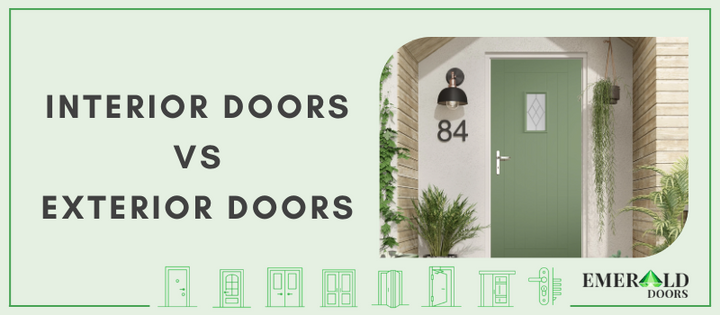
What is the Difference Between Interior and Exterior Door?
Doors are classified majorly into two categories - Interior doors and Exterior doors. Whether a building is residential or commercial, every building requires interior and exterior doors. Though both interior and exterior doors might look similar, they differ vastly and they are also constructed for serving different purposes.
There are certain factors that differentiate interior doors from exterior doors. Both the doors may seem the same for those without proper structural knowledge. We have curated a complete list of all the differences between interior doors and exterior doors.

Let's take a closer look at the differences between these two types of doors.
1. Appearance
Interior doors come in a variety of styles and colours, whereas exterior doors are available in limited styles and colours. Interior doors are usually more decorative than exterior doors as they don't need to be as durable as them.
Interior doors are more delicate than exterior doors because they usually do not include weather-stripping features. However, exterior doors are made up of thick, solid layers with additional glazing features for additional protection.
2. Material
Interior doors normally feature a hollow core. As interior doors are required to serve a single purpose in your home, they are usually made up of single material such as wood or fibreglass. Due to some stylish purposes, interior doors can also be made of a combination of materials.
On the other hand, exterior doors are required to withstand weather abuses and also be sturdy and durable at the same time. Therefore, they are made by combining several materials with reinforced metal frames such as wood, metal, fibreglass, and many more.
3. Thickness
Exterior doors are constructed to be thicker and denser than interior doors. Interior doors usually feature hollow cores, while exterior doors feature solid cores, as exterior doors are required to be more energy-efficient.
Interior doors are subjected to less wear and tear than exterior doors and hence do not require an extra thick core to keep the heat in and cold out. While interior doors are made for easy use, exterior doors are made to provide a protective barrier.
4. Functionality
Exterior doors are required to protect properties against weather calamities and burglars. In contrast, interior doors are required to create privacy and work as a divider between two rooms.
Exterior doors must have a good locking system to protect against home intruders. However, a normal lock would work for interior doors, as their purpose does not require digital or high-quality locks.
5. Insulation
Both interior and exterior doors require different insulation levels, depending on their durability features. Usually, interior doors are not insulated due to their hollow core, but in certain cases, they do require insulation. Solid cores provide a better level of insulation than hollow cores.
The main purpose of insulation is to provide a security layer for the door. An interior door's main function is to divide rooms and spaces, so it can work without insulation, too. Although some interior doors are constructed with optimal insulation capabilities, they are not as energy-efficient as exterior doors.
6. Sizing
As the exterior doors serve as the main entrance and exit points in any residential or commercial property, they are larger in size when compared to the interior doors. The standard size of an interior door is 30’ to 32’ inches, while an exterior door is required to be at least 36’ inches.
Exterior doors must meet certain sizing requirements in order to be effective. This is because exterior doors need to be able to withstand the elements while also being energy-efficient at the same time.
7. Cost
Exterior doors are usually made up of high-quality materials and are required to be heavy-duty and secure. This makes the exterior doors more expensive when compared to interior doors.
However, this doesn’t mean that an interior door should be used instead of an exterior door, as the heating bill will make up for the difference in the cost of both types of doors.
Conclusion
Whether you are looking to purchase an internal door or an external door, Emerald Doors offers a wide range of options based on your preference and budget.
Difference Between Interior Doors and Exterior Doors FAQs
Can I use an interior door as an exterior door?
It is not recommended to use an interior door as an exterior door because they are not made to withstand the elements. Additionally, interior doors are not as energy-efficient as exterior doors.
Are interior and exterior door frames the same?
No, interior and exterior door frames are not the same. Exterior door frames are made to be more durable and energy-efficient in order to keep the heat in and the cold out. Whereas, interior door frames are not required to meet these same requirements.
More Articles on Internal & External Doors